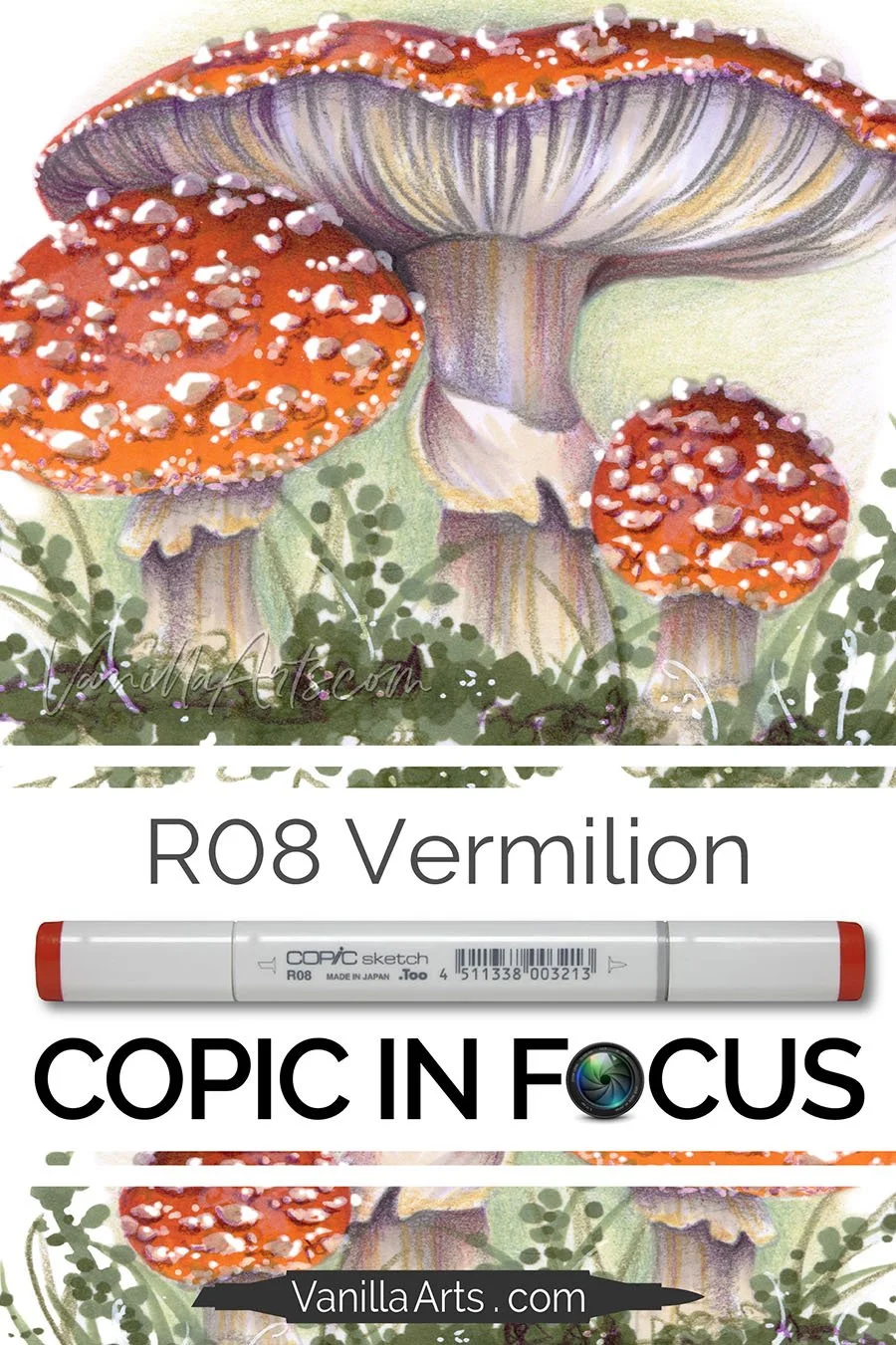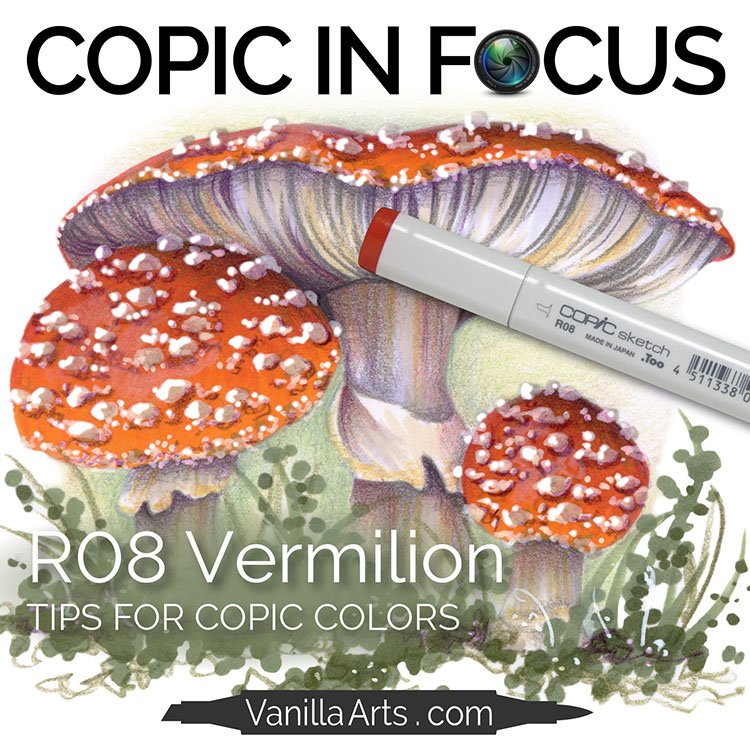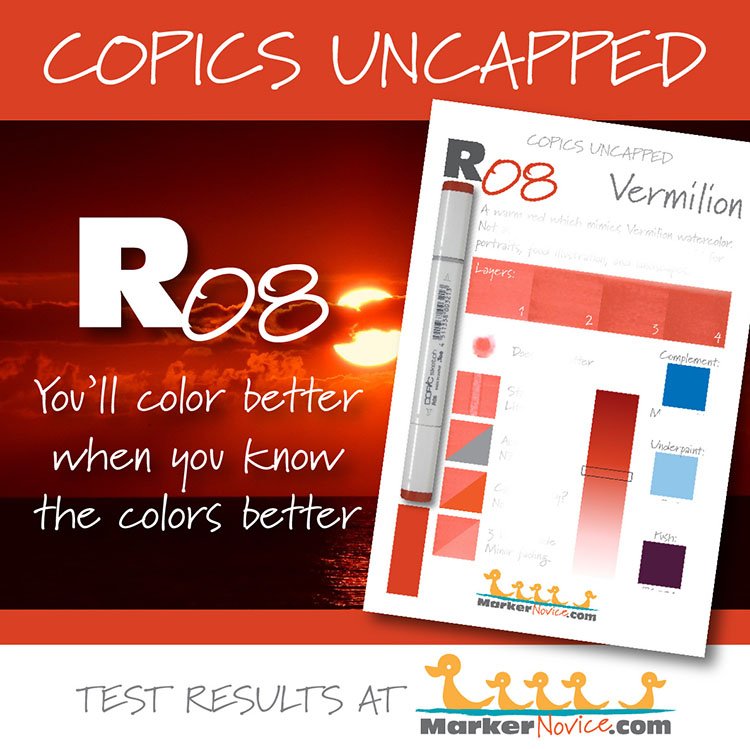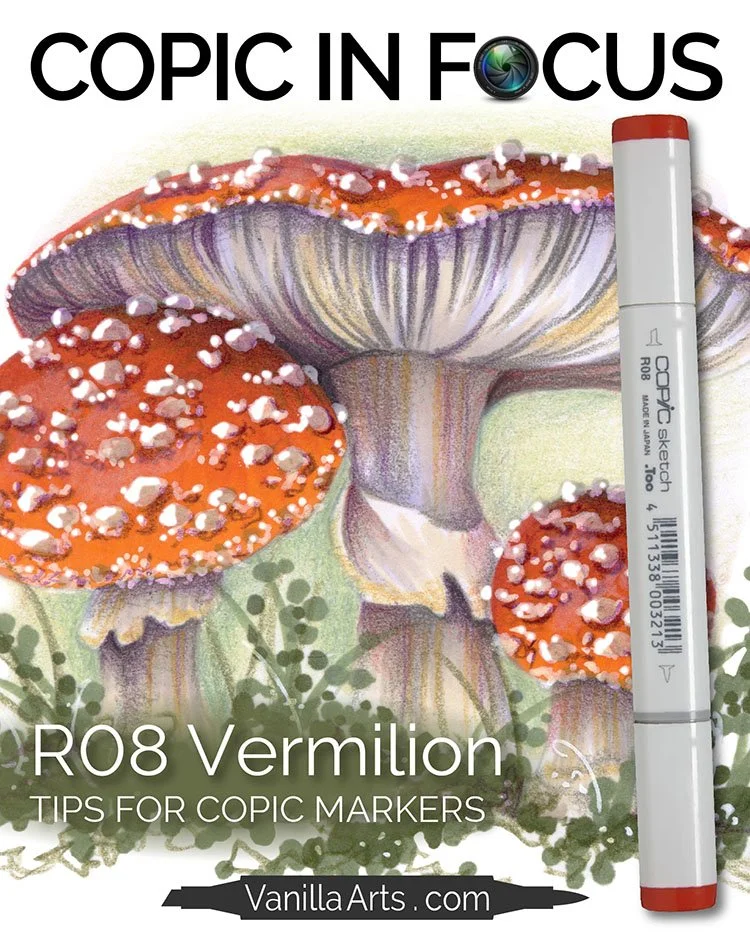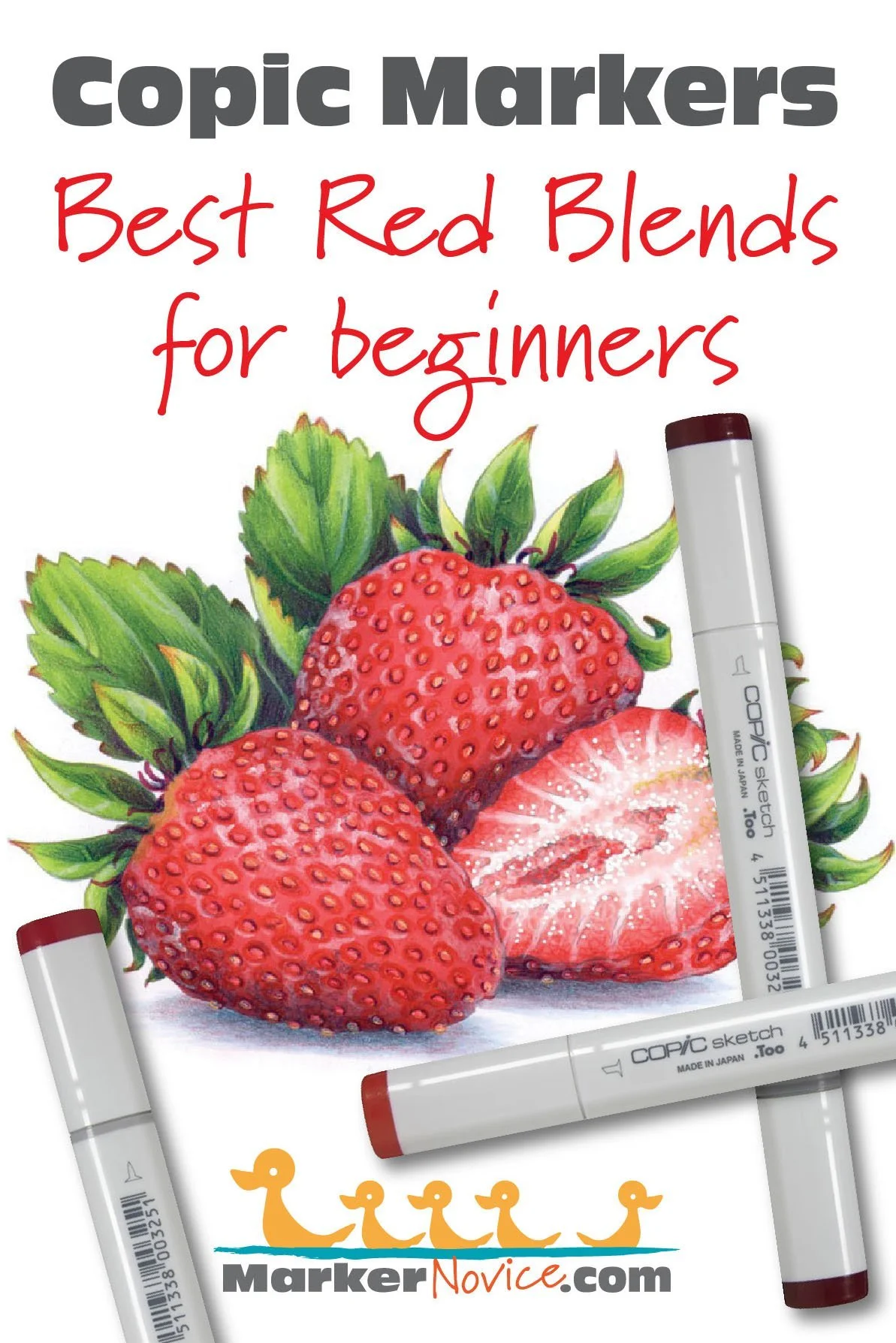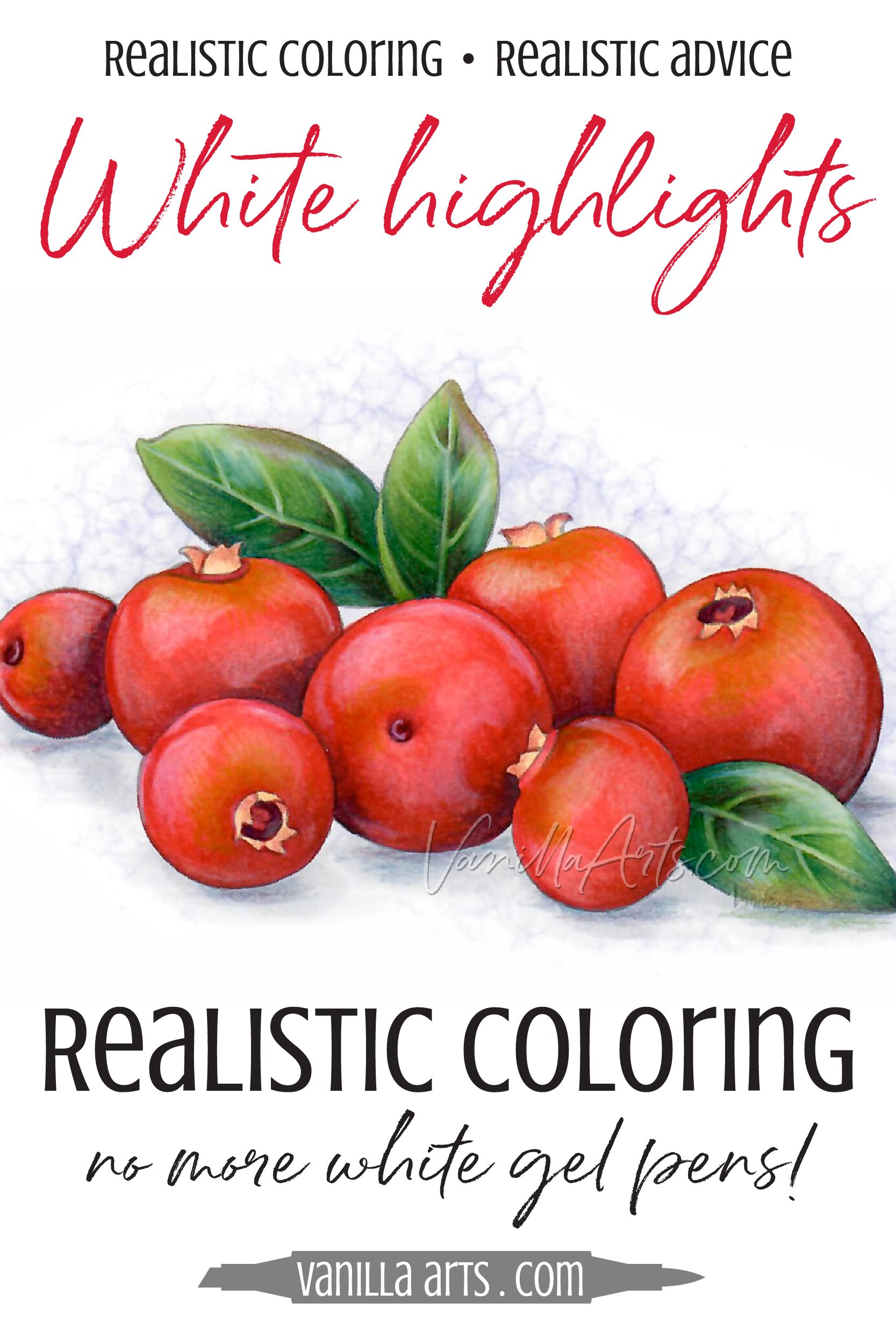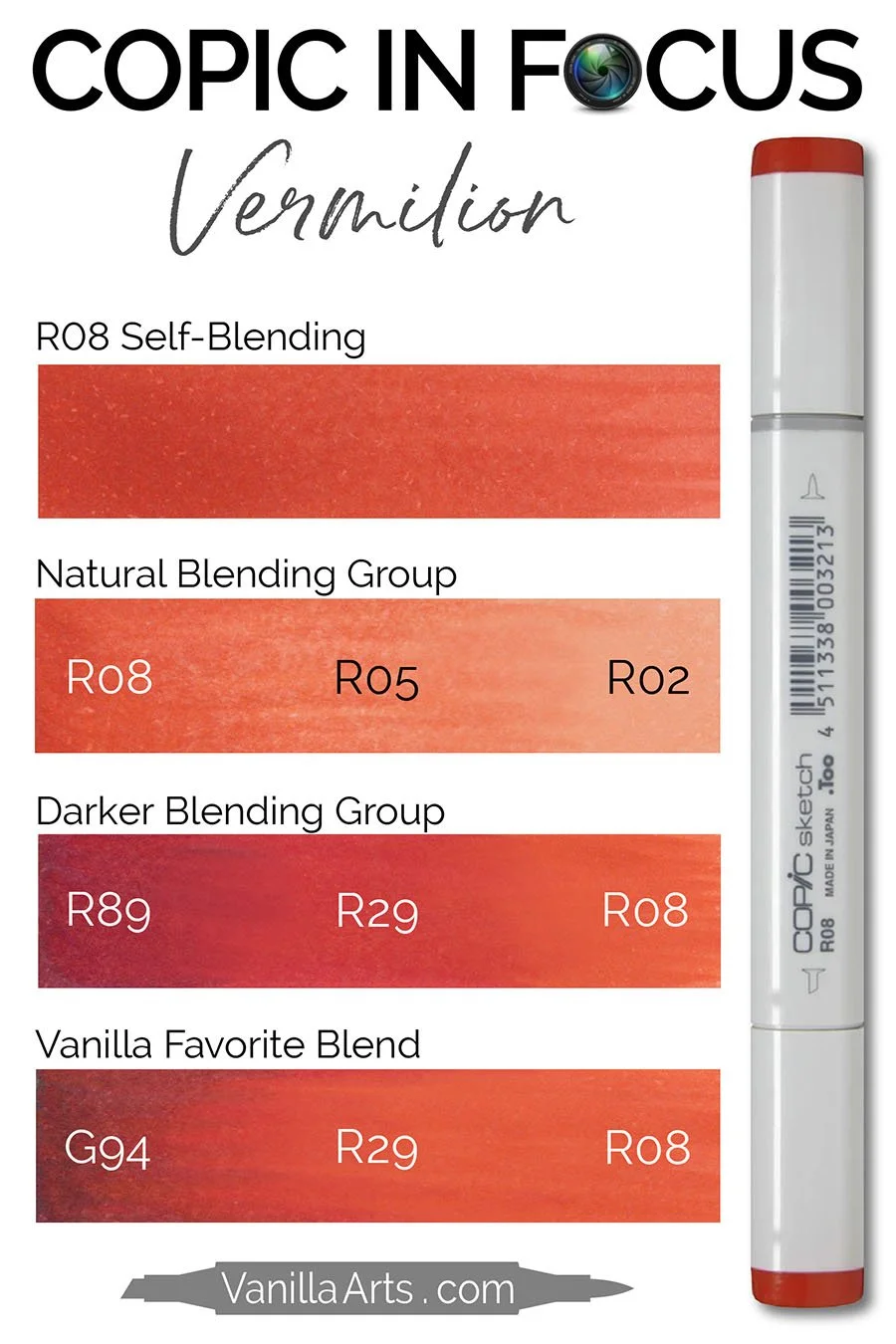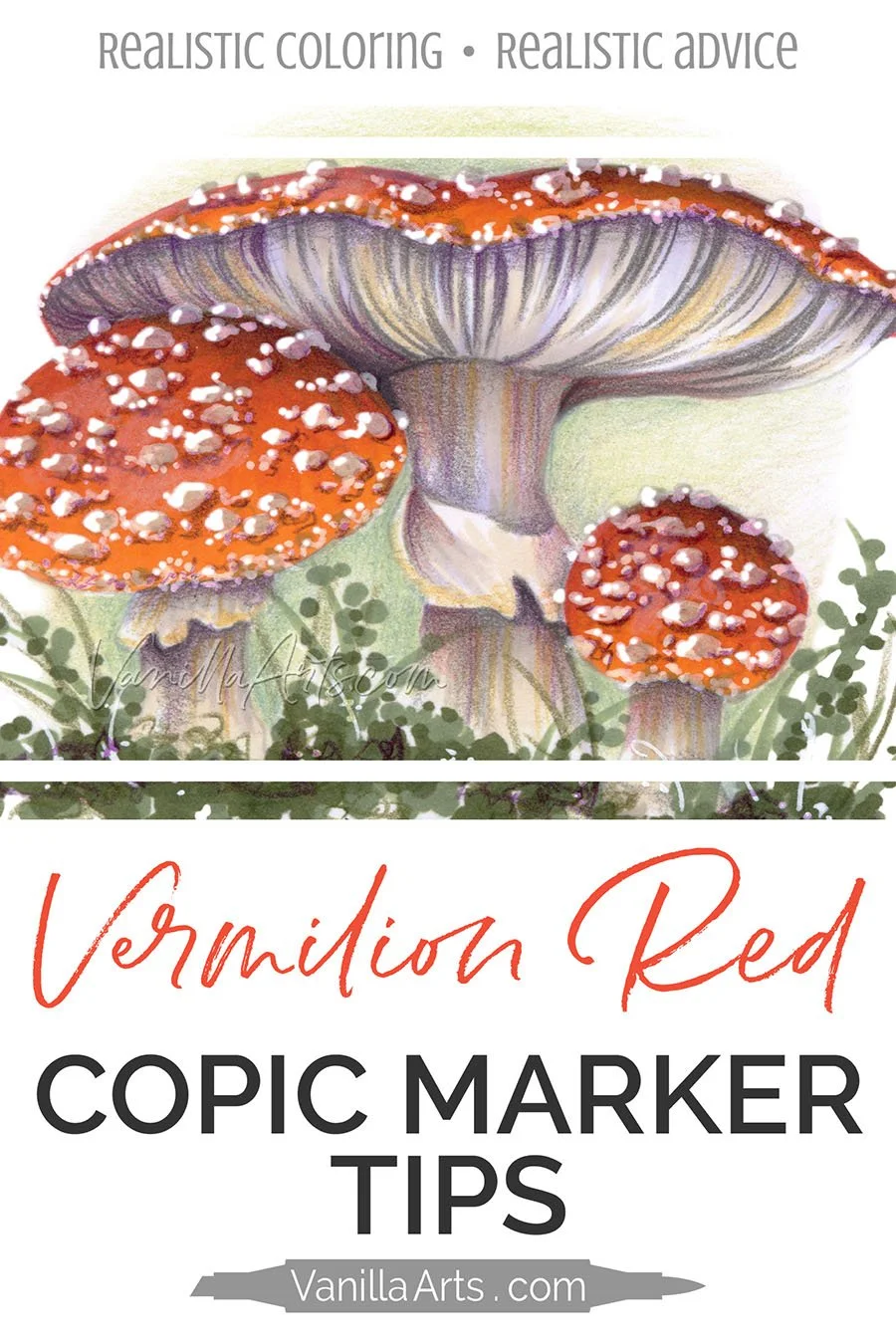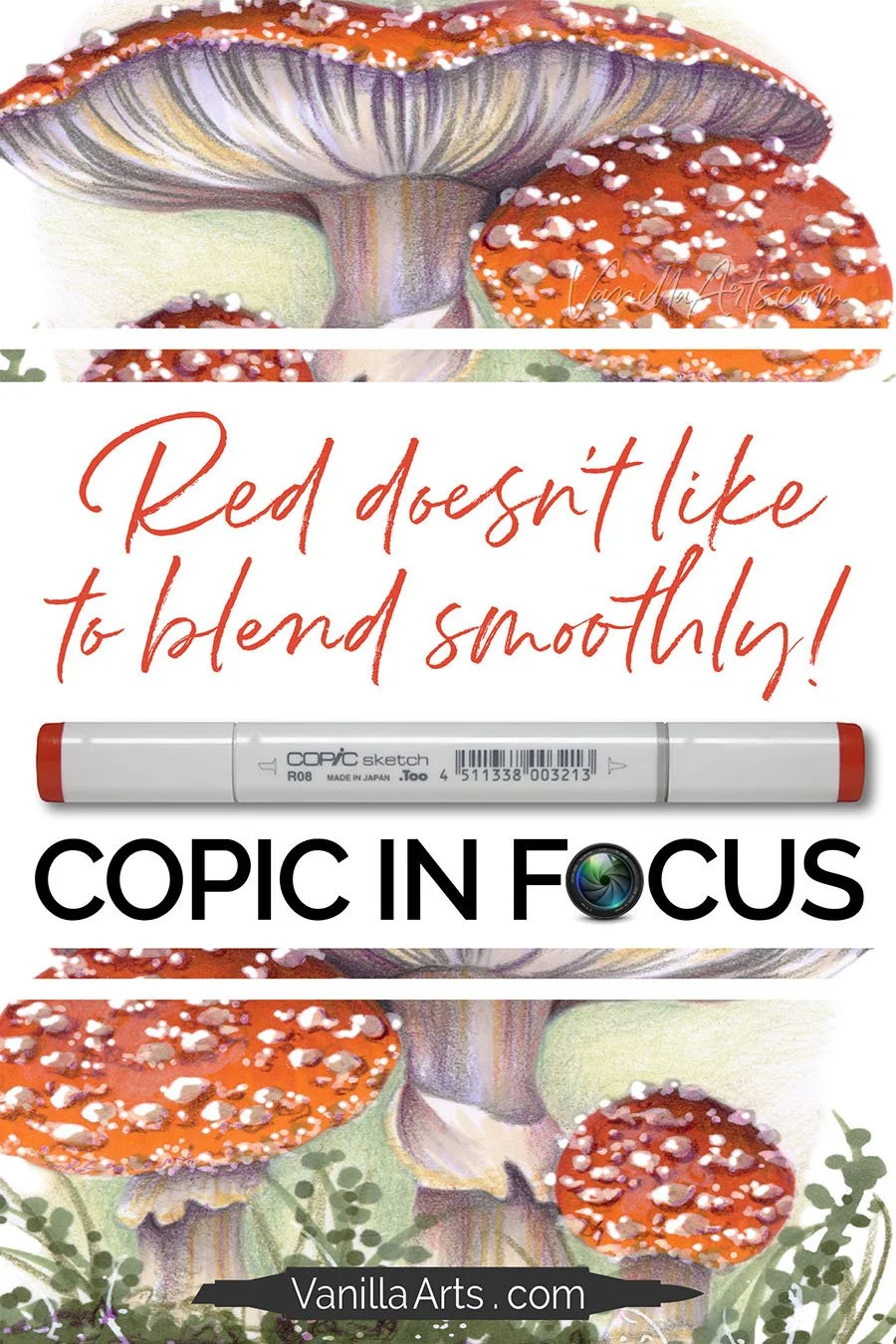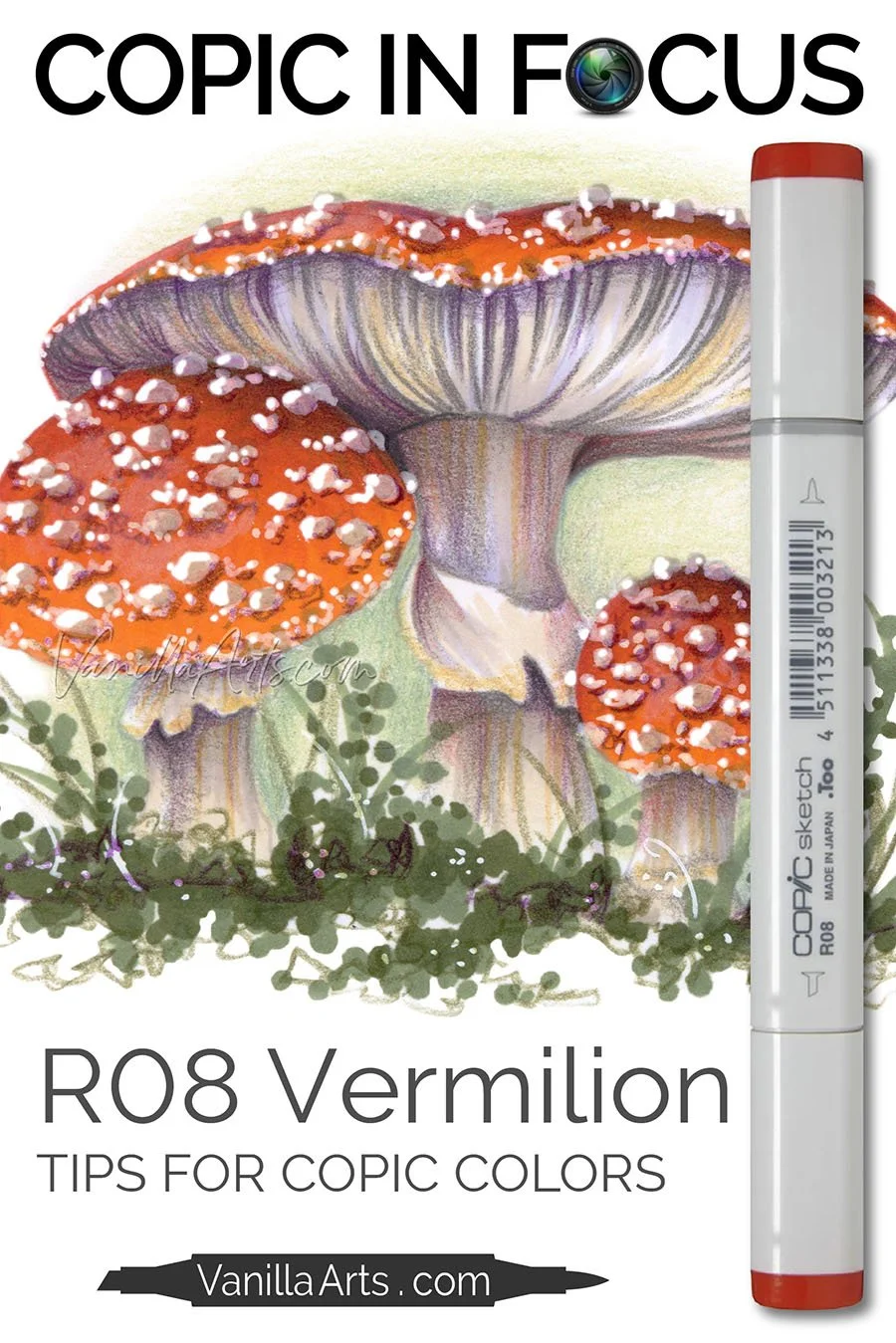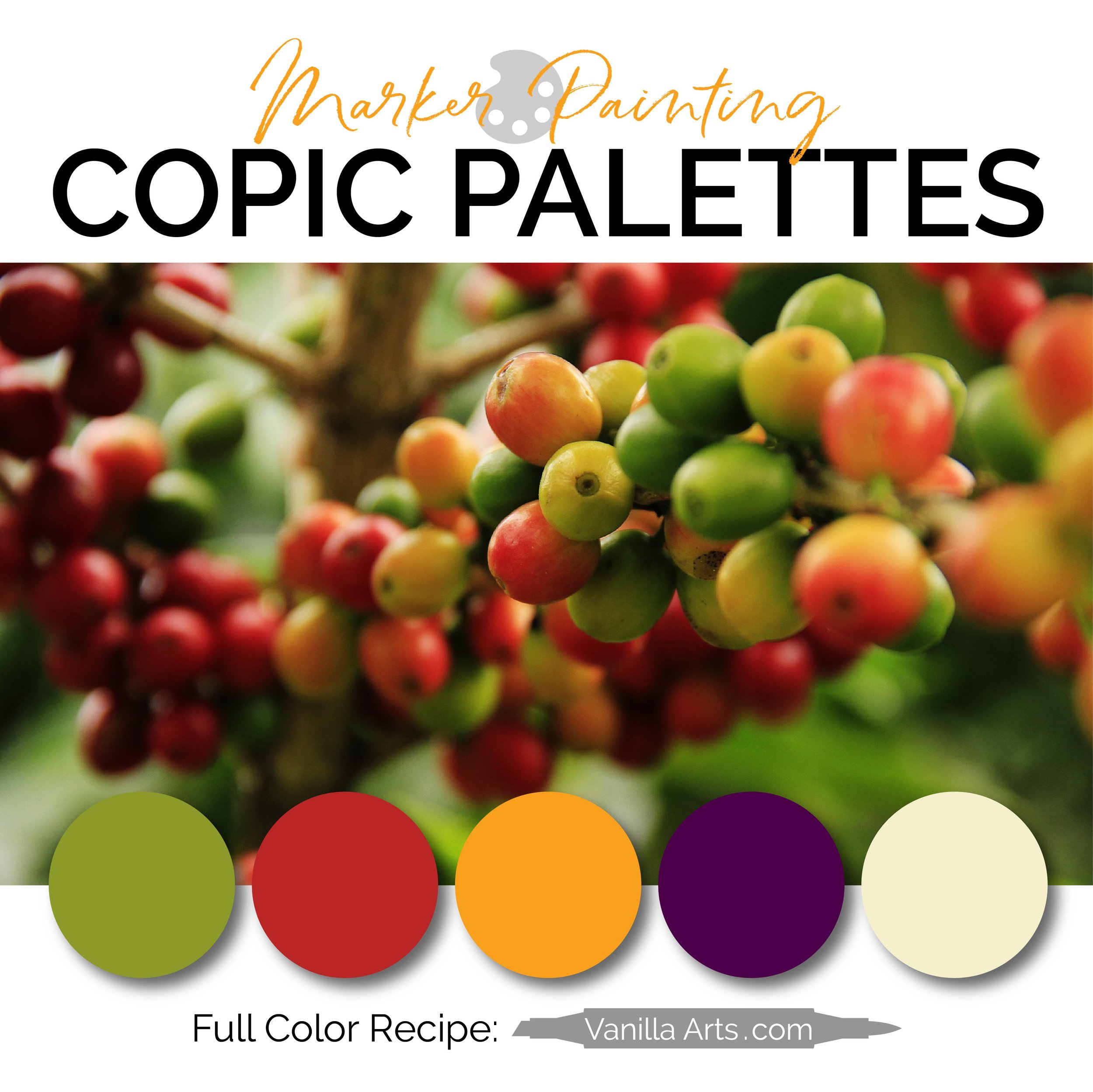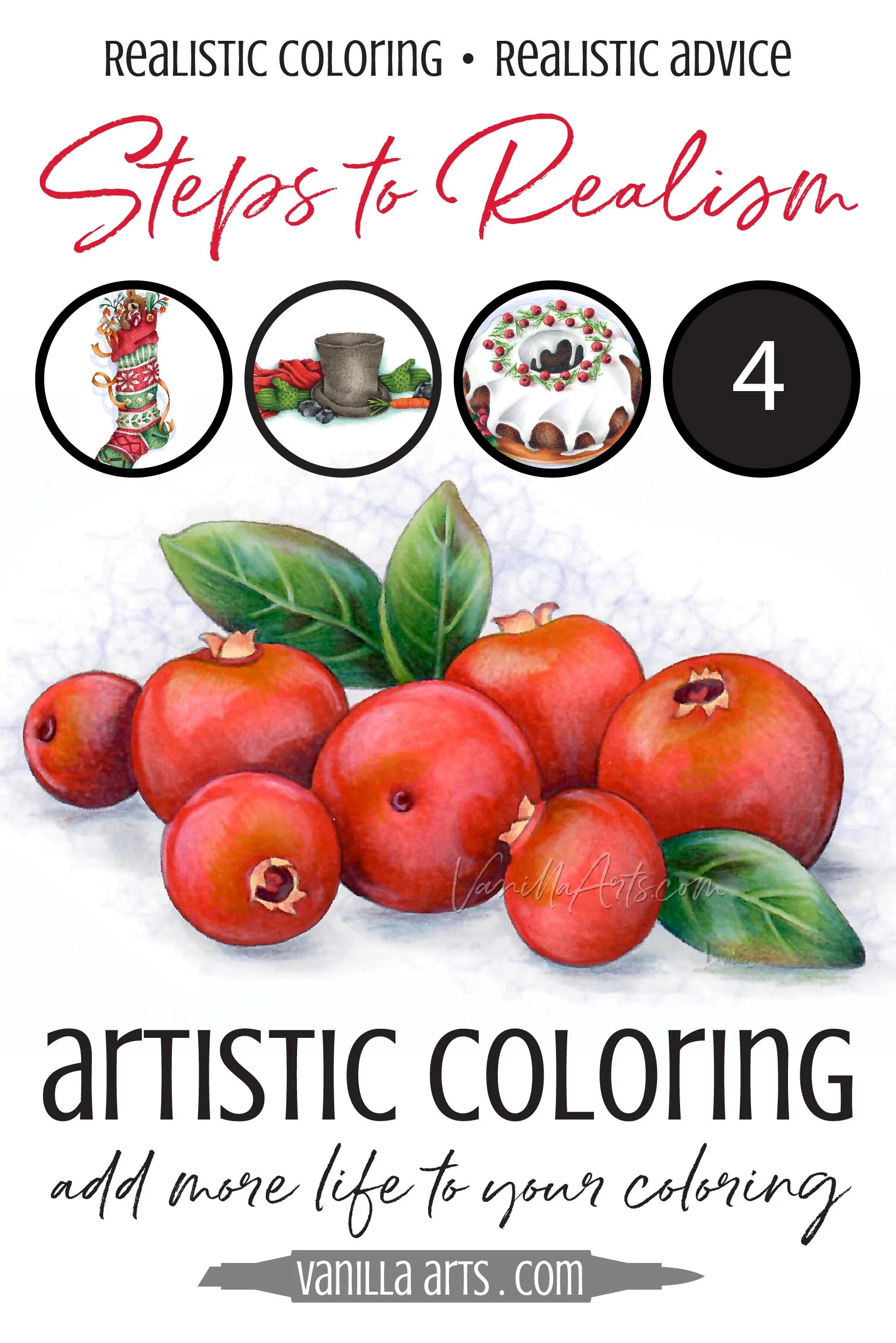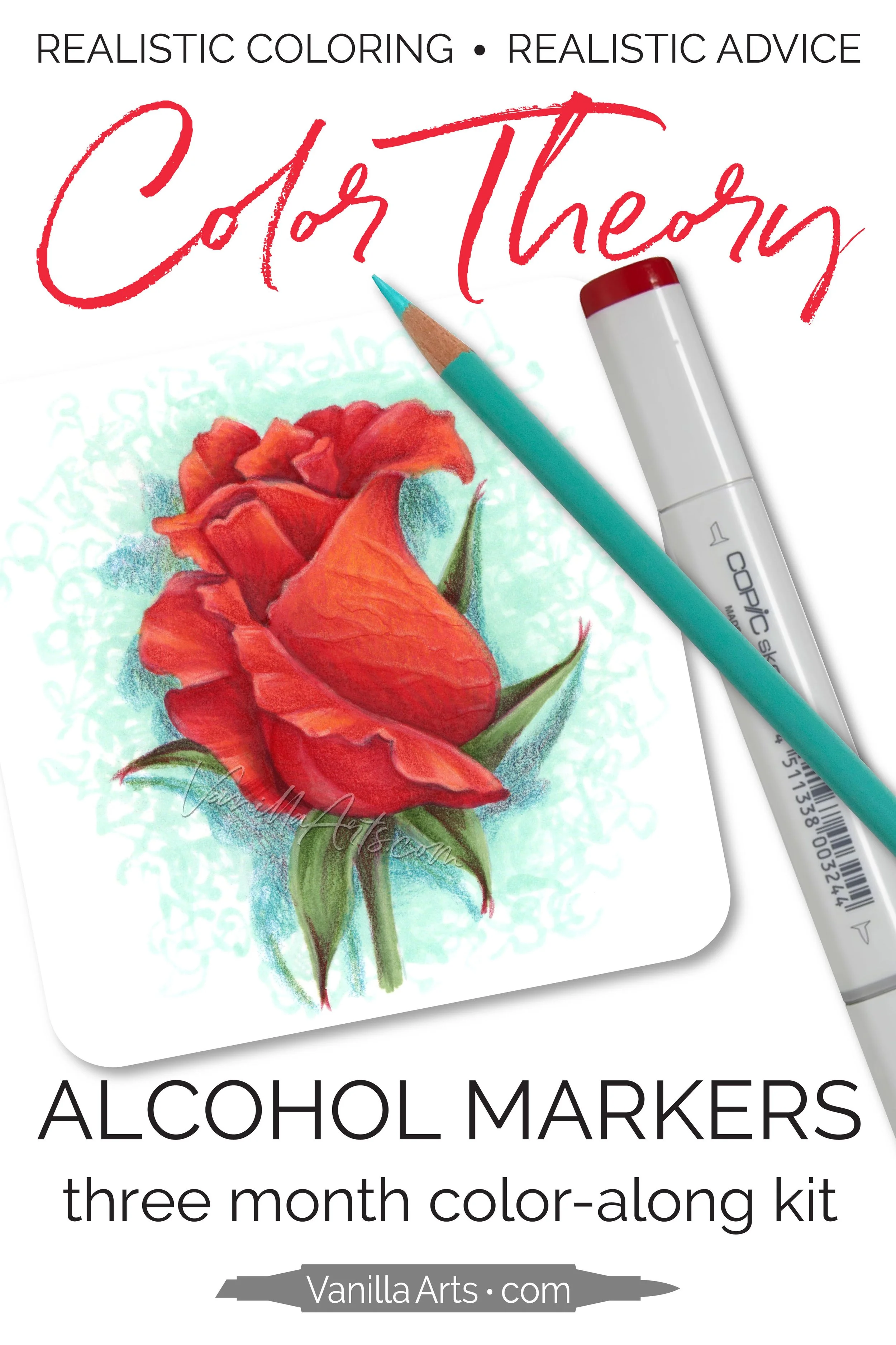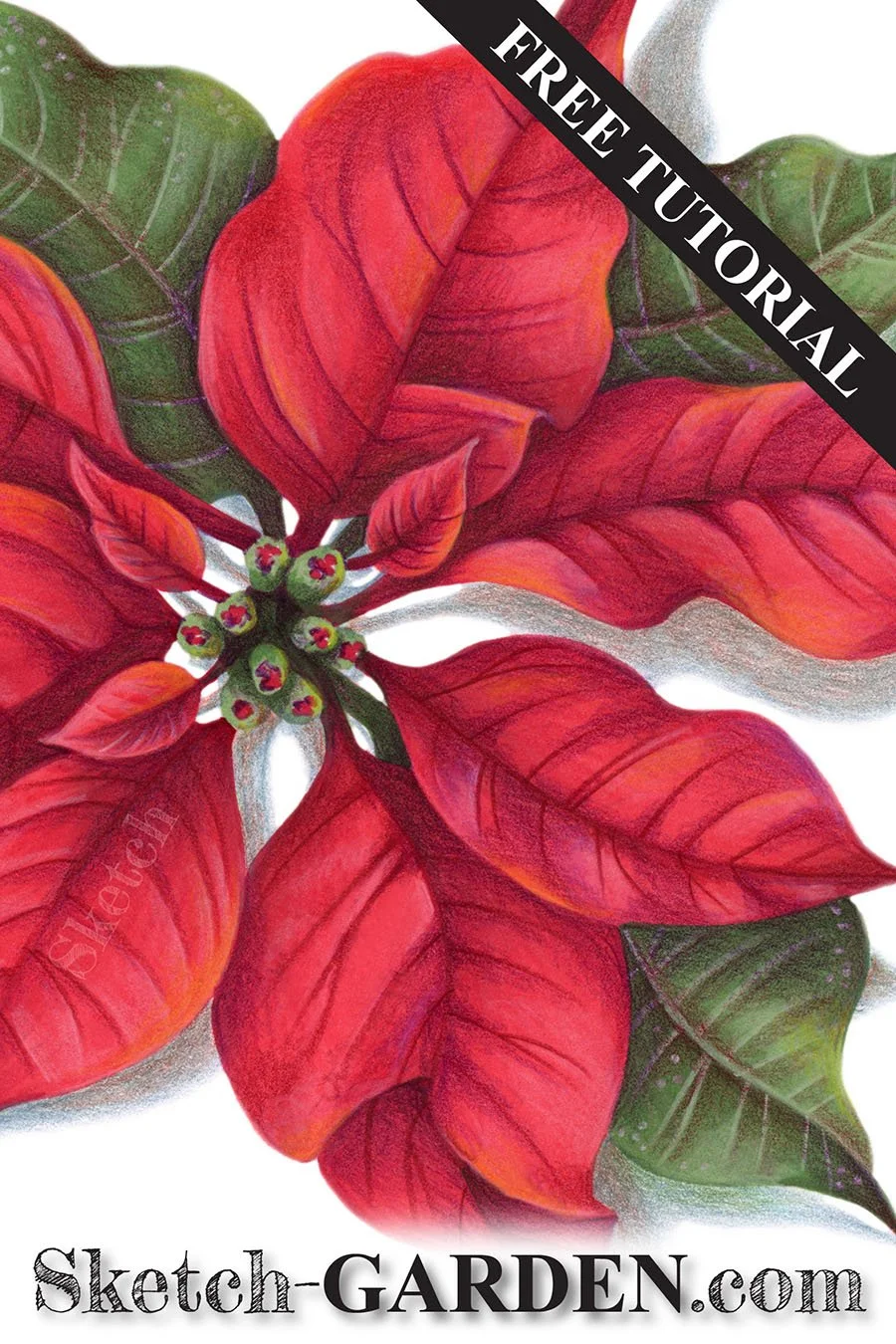Copic Marker R08 Vermilion (Coloring Tips for Warm Red)
What’s a good blending combination for Copic R08?
I get it— everyone loves a good blending recipe.
But I’m always sad when someone asks for a marker combination as if that’s the trick to mastering a unique color. I’ve taught Copic classes for a decade and I’ve used alcohol markers professionally for 30 years; if there’s one thing I’ve learned:
There’s more to Copic Markers than a binder full of blending combinations.
Markers can do more than blend but if all you know about R08 is that it blends with R05 or R29, you’ll never tap into this marker’s true potential.
Today, we’re looking at Copic “Vermilion” from the artist’s perspective— how does R08 work and is it an asset or a liability for our art?
Let’s get past basic blending and find out how this marker really performs.
Copic R08 is a warm, organic, orangish red
Imagine picking a ripe red tomato from the garden. You slice the tomato to reveal the juicy seeds and tangy flesh.
This is R08, a mouthwatering tomato red.
R08 is technically a scarlet red. Scarlet reds are warm in temperature and this Vermilion shade teeters on the brink of orange. It’s perfect for coloring natural reds, the kind you see in the flower garden and the produce section of your grocery store.
About the Red R Color Family:
Copic makes a wide range of pretty reds spanning from warm to cool. Most of Copic’s reds are cool but the R-Zeros and R-Teens are warm with 11 values to choose from.
About Copic’s R “Zero” Ink Group:
R08 is part of the “Zero” group of R markers— the first number in the ID code tells you the group number.
In general, Copics that start with 0 are bright colors- the Zeros are usually the most saturated group in each color family. Many Zeros appear neon or day-glow. This is not true with the R-Zeros, they’re not obnoxiously bright like the Y-Zeros, YG-Zeros, or B-Zeros.
The Zero group includes the sub-zeros— 00, 000, and 0000. Sub-zeros are always the lightest markers in every color family. R00, R000, and R0000 are made by diluting R08 ink with a large amount of solvent, making them just a whisper of the original warm red color.
Learn more about the Copic Numbering system in my article at MarkerNovice.com here.
The R-Zero family should all be dilutions of R08. However, sometimes Copic slips a stray marker color into a group because there’s no other place to put it. Stray colors may look similar but they will not blend as well with the group because they’re not chemically related. I suspect R02 is odd based upon how it interacts with R05. This is why the blend R08-R05-R02 sounds easy in theory but is always a challenge to smooth in real life.
About the Color Value:
The second number in the code R08 is 8. This indicates that R08 is at the darker end of the R-Zero group (nine would be the darkest if they made an R09).
R08 measures lighter on the value scale than promised. R08 should be named R07 because the ink physically matches a 7 on the Copic value scale. To make matters worse, the plastic color indicator on an R08 cap is darker than the ink color. Using R08 for the first time is a surprise— we expect it to be darker than it actually is.
Watch me color with R08 in this FREE video at YouTube
(click below to be taken to the video at YouTube)
About the Name “Vermilion”
R08 is named after Vermilion, a pigment made from a mineral called Cinnabar. Cinnabar is brick-red in color. Over time, Vermilion has become synonymous with orangish red.
Copic color names can be odd; perhaps they don’t translate well from Japanese to English. It’s frustrating that many Copic colors do not resemble the object or color they’re named after.
In this case, the marker name is completely accurate. R08 Vermilion is an excellent example of warm red. You’ll find many paints with the same name and color in every art store.
Is Copic R08 Lightfast?
Does it fade quickly? Can it be erased? Does it shatter? Does the cap match the ink color?
I’ve tested R08 ink to help you make the most of this marker color.
See the test results for:
Lightfastness
Layering
Color Build-up
Dilution
Value
Cap Accuracy
Reaction to Colorless Blender
MarkerNovice.com is the sister site to VanillaArts.com where I offer reliable information for Copic Marker beginners.
Substitutes for Copic R08 Vermilion
Remember: similar colors always have different chemical formulas. They may look close but that’s where the similarity ends.
One color can blend like a dream while a similar color can be stubborn, staining and hard to blend. Too many people blame their own lack of blending talent when it’s actually a chemical imbalance with the substitute color.
All of this is to say that color comparison charts don’t tell the full story. Every substitute is a change in chemistry which can result in funky blending results.
If you don’t own R08 and you’re looking to substitute a similar red…
R17 is a smidge lighter and less vibrant. It’s a good substitute for R08 because they’re similar in temperature.
R27 is cooler than R08. Most people would call R08 “orangish” and call R27 a “red-red”. In my opinion, a good collection would include the full group of R-Zeros and the full group of R-Twenties.
A sample of Copic R08 in use
To be honest, when I looked through a decade of my red projects, it seems I favor the R-Teen family and especially R17 when I need a warm red.
So I colored this set of Fly Agaric Mushrooms (Amanita Muscaria) to highlight the warm beauty of R08 Vermilion.
I’ve paired R08 with R05 and YR16 plus a murky green underpaint.
For more blend details, watch me color this project here:
R08 and R05 is an easy blend— not surprising because they’re both the same ink. R05 is simply R08 with extra solvent in the formula.
Logically, Copic wants you to blend three markers from the same number group. R08 - R05 - R02 is considered a “natural” blend because they all start with “0”. R02 is terrible in this combination, it doesn’t want to blend with R05 and eats away at the vibrant red. I hate this blend and I will not teach it in classes.
For the mushroom project, I use YR16 as the lightest color in the blend. This adds a golden glow to the edge of each mushroom and mimics the red to orange gradient I see in Fly Agaric photo references.
Read More About Red:
Click to visit more orange coloring articles here at Vanilla Arts
Blending Combinations with Copic R08 Vermilion
Here are four sample blends using R08.
In the Self Blending swatch, I’ve applied one, two, and three layers of R08 to create a warm red gradient.
You can tell it’s only one coat on the far right because of the streaks. One layer of ink never looks smooth!
People don’t often think about blending a marker with itself but self-blending is the easiest beginner blend. Markers always blend well with themself!
Next I have a natural blending combination using R08 as the darkest marker.
A natural blending combination is three markers which all share the same first number.
Natural blends are usually easy blends but I do not recommend this blend. R02 is a finicky color with too much solvent in the formula to blend well with R05. The R02 damages the red vibrancy and it’s hard to smooth this end of the blend.
The Darker Blend uses R08 as the lightest color. It is popular to use R39, R59, or R89 as the darkest red in any red combination. Because Copic does not make an R09, I’ve used R29 to bridge the gap between the R89 and R08. Notice that because R89 and R29 are cooler in temperature, we’ve lost the warmth of R08 in this combination.
The last swatch is my favorite and this is the blend I used in the “Red Capped Mushroom” project featured in this article. G94 is a dusty green color. I used G99 and G94 in the grass below the mushrooms so it was logical to use G94 underneath the red for the shady side of the mushroom caps.
Tips for Blending R08
Note: Red is always a staining color which means it will never blend as easily as beginner friendly, non-staining colors like blue, gray, or yellow. But we can’t avoid red, so here’s how to deal with it:
If you’re new to blending, start with the R-Zero group (including R08) or the R-Teen group. These warm reds have a bit of yellow in their ink formulas. The yellow component makes them easier to blend than any of the other R markers.
Work fast— Don’t let R08 dry on the paper before blending. The longer it sits, the more firmly it grips the paper. The best red blends will always be wet on wet.
Be generous with your lightest blending color— No blend works well when you skimp on ink but stubborn colors require extra juice to blend smoothly.
Because R08 has a strong orange vibe, it pairs well with many YR markers. YR markers always have a bit of yellow ink in their formula and yellow is always an easy blending ink. Adding YR to a R blending combination increases your ability to blend the color smoothly.
The most important tip for coloring with warm red markers:
I don’t know if it’s because beginners only have a few markers or if there’s something odd about how people see color…
Most hobby colorers use one of three burgundy reds to shade every red blend. I can not count the number of instructors and tutorials who teach this shading method.
I strongly disagree.
Do not shade warm red with cool red.
If you look at the real red objects around you, the coffee mugs and throw pillows or red sweaters…
Warm red doesn’t magically turn cool as it gets darker.
Go look. Find an orange-red something, anything. Do you see blue anywhere?
Hobby colorers usually follow the recommendations of other colorers. So it’s no surprise— everyone shades R08 with R39, R59, or R89 because everybody says so. But…
R39 is cool. It has pink undertones.
R59 has strong blue undertones.
R89 adds a grayed element to the blue.
Have you ever noticed that many red roses and Santa hats colored with Copic look burnt or blackened? It’s everywhere when you finally notice it.
The reason amateur reds have blackish shade because someone is accidentally mixing temperatures!
Warm Red + Cool Red = Yucky Red
Don’t do it. There’s a gentler way to shade warm red. I teach it in this free video:
Shade and Highlight Suggestions for R08 Vermilion
I teach a complementary underpainting method rather than standard blending techniques.
In underpainting, we choose opposite colors on the color wheel to add the realistic murkiness found in real-life shade. We “desaturate” with complementary colors. Read more in my article series here.
Then, after I underpaint with Copic, I come back with colored pencils to boost the shade and add highlights.
My underpaint colors and my pencil colors rarely match the markers.
Shade suggestions for R08 Vermilion:
Copic Underpaint— B12, B32, B93, BV20 or BV23, V04, or V22. These add a bit of coolness but because the R08 is dominant, you don’t loose the warm vibe. You can also experiment with greens like BG93, G94, or YG95.
Prismacolor Pencil Overpaint: PC931 Dark Purple, PC1009 Dahlia Purple, PC937 Tuscan Red, PC625 Crimson Lake, or PC1030 Raspberry. In the mushrooms here, I used PC1097 Moss Green and PC931 Dark Purple.
Highlight suggestions for R08 Vermilion:
As the lightest color in a R08 bending combination: R14, R24, or use YR16 as I did with the mushrooms.
Prismacolor Pencil Overpaint: I used PC914 Cream but I also like PC940 Sand, PC917 Sunburst Yellow, or PC916 Canary Yellow.
Is R08 good for beginners?
Red is never easy for beginners but since we can’t avoid it entirely, I think the R-Zero family and R08 are a great place to start.
I teach beginner classes with R29 because if you can blend R29, you can blend anything. But if you’re self-instructing, R08 is a smarter red to begin with.
Remember, even advanced colorers occasionally struggle with red.
If you’re building a small but powerful Copic collection, I highly recommend one set of warm reds and a set of traditional reds:
Warm: R08, R05, R14, R02 (adding 14 makes the blend easier)
Traditional: R29, R27, R24, R22
Read more about my starter set with tips for building your marker collection in my article here.
Copic Postcard Kit
Lets learn to color with R08 plus a full fall color palette.
Copic Postcard Kit
Perfect for every skill level
Six easy-print PDF postcards + swatch cards
The Colors of Autumn: Gold, Orange, Vermilion, Brown, Sage, and Lavender
Perfect for Copic Markers with or without colored pencils
Class Printable Pack Includes:
SIX digital stamps, one for every color- YR16 Pumpkin, YR24 Mulled Cider, E29 Pinecone, BV31 Dried Hydrangea, YG93 Chestnut, and today’s R08 Red Capped Mushrooms
SIX easy-print PDF swatch cards for every color. One card includes Amy’s color suggestions, the second is blank for your experiments
Cards are sized 5x7” with margin room for binding into a color reference booklet
Red Marker Blends & Palettes
Use our Vanilla Undercover swatches to add realistic depth and shade to your next coloring project.
Copic Palettes use color theory to create the perfect color scheme for your next marker project.
Red: Online Classes, Kits, and Digital Stamps
(Click for more info)
Supplies used in Red Capped Mushrooms
Vanilla Arts Company is a participant in the Amazon Services LLC Associates Program, an affiliate advertising program designed to provide a means for use to earn fees by linking to Amazon.com.

